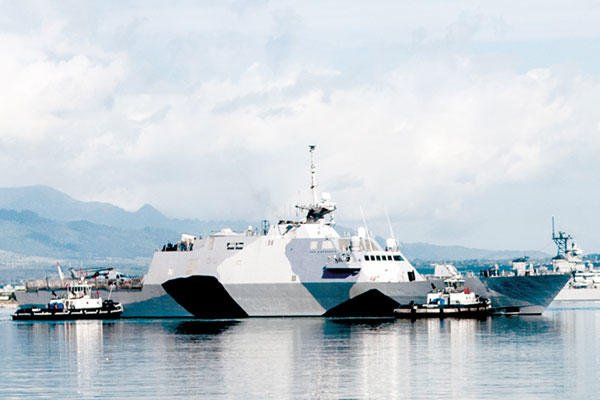Congressional support for the Navy's Littoral Combat Ship appears to be waning even further after an influential U.S. House of Representatives subcommittee proposed slowing down the pace of production for the vessel.
The House Armed Services Committee Seapower and Projection Forces subcommittee has proposed legislation that slows the rate of purchase for the LCS from three to two per year.
The subcommittee supports the LCS program and the development of a new small surface combatant, but priorities such as refueling the USS George Washington and ensuring that the Navy can operate an 11-carrier fleet took precedence in the budget, said a congressional staffer close to the subcommittee.
"We had to look holistically at the whole budget and shipbuilding account, we had to make some tough choices," the staffer said.
The mark up is the latest in a series of setbacks for the controversial LCS program, which was truncated from 52 ships down to 32 by Defense Secretary Chuck Hagel in January of this year.
Citing concerns about the ship's survivability and lethality, something echoed by members of Congress, watchdog groups and analysts, Hagel directed the Navy to come up with alternative proposals for a new small surface combatant in time for 2016 budget deliberations.
As a result, the Navy leadership stood up the Small Surface Combatant Task Force as a special entity designed to explore the realm of the possible regarding alternative proposals for LCS. The idea is to identify alternatives designs and configurations for the last 20 ships and engineer a survivable small surface combatant ship able to travel in shallow-waters and conduct a wide-range of missions.
The SSCTF, established in March of this year, is tasked with coming up with alternatives for a new shallow-water, multi-mission combatant that is more survivable and lethal than the existing LCS.
Now, the small Navy task force is asking industry to offer its best ship-design ideas, technologies and systems to inform concepts and development for a new small surface combatant slated to replace the last 20 plan Littoral Combat Ships.
The Navy's SSCTF released two Requests for Information to industry; one of them asks for ship design concepts and input and a second one asks for detail regarding ship technologies and systems such as electronics, weaponry and radar, said John Burrow, Marine Corps Systems Command, head of the SSCTF.
"This will give us a better idea of what is technically feasible. It will give our team a good idea of what the risks and costs are," Burrow added. "We're looking for what systems and capabilities do you have out there right now. The RFI's will ask for specific information that will give us insight into ship integration requirements. What are the primary second and third order cost effects? It is a fairly detailed list of information that we are looking for.
Burrow said the task force is exploring modifications to existing Independence and Freedom variant LCS ships as well as looking at designing a whole new ship altogether. Led by Marine Corps Systems Command, the task force includes large elements of personnel from Naval Sea Systems Command and the Navy's surface warfare requirements office.
Potential designs and technologies for the new small surface combatant will be analyzed according to cost and key capability areas, Burrow explained.
"There are a number of capability sectors what will be considered. It will include air warfare, surface warfare, undersea warfare and mine-warfare," he said.
The task force is also looking at key ship attributes such as speed, range and endurance, Burrow added.
The pre-solicitation language released prior to the RFIs explains some of the vision for the ship.
"This type of ship provides combatant and fleet commanders a uniquely suitable asset for theater security cooperation tasking and select combat operations, freeing large surface combatants to perform other missions. These small surface combatants build and strengthen maritime partnerships by being able to train and operate with smaller, regional navies and to enter previously inaccessible, shallow-water foreign ports."
The goal of the SSCTF effort is to generate a series of alternatives for Navy and Pentagon leaders by the end of July of this year, Burrow said.
"In the end we will come up with design alternatives tied to a capability concept that will be closely linked to some requirements, engineering and analysis work that will provide the benchmark for requirements," he added.
The SSCTF also plans to solicit input from Sailors and Navy officers through several fleet workshops, one in Norfolk and another in Hawaii, Burrow explained.
"We are going to go and solicit their feedback on missions and capabilities to get an idea of what they value most. We will roll that in to our development of capability concepts which will be the development of design alternatives," he said.
-- Kris Osborn can be reached at Kris.Osborn@monster.com.






























